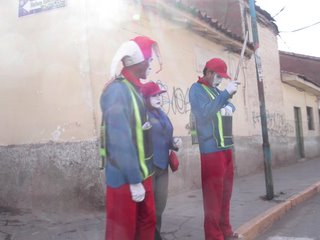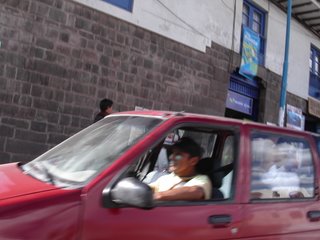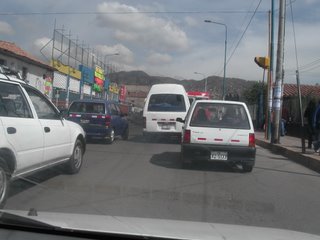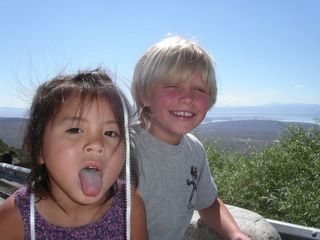Getting around in Cusco can be an adventure in itself. Given the general pleasant surroundings and amiable climate, walking is the preferred mode of locomotion but for slightly longer trips or when transporting loads or children or loads of children, taxis are preferred. Generally, a taxi will take you anywhere near the city center for two Sols (about $.60) during the day or three Sols (about $.90) at night. The taxis are almost all of two varieties. The most common are the Daewoo Tico which is not much larger or more powerful than an enclosed go-cart. The alternative is the Toyota Corolla wagon, which has the advantage of the cargo area in the rear for either goods or people. I’ve personally ridden in these taxis with over seven adults and more than a few kids. Both cars are hand-me-downs from abroad. The former were shipped to Cusco upon expiration of their useful life as taxis in Korea and the latter arrived after they exceeded their legal life as taxis in Japan. While some might be concerned about the condition of taxis which others have been decreed as too old and decrepit for safe public transportation, such fears are soon eclipsed by the driving habits of the Cusco drivers. Traffic rules in Cusco are much more fluid than those in the States. Signals are rare and stop signs treated as mere suggestions. Once traffic is flowing in one direction, it continues until stopped by another stream of traffic. Such a system is actually a bit more efficient as much less time is spent stopped at intersections. Drivers squeeze in wherever they can fit and traffic lanes are created on an as-needed basis. Right turns are often made from the far left lane across many rows of cars and, for some reason which I was never quite able to determine, left turns often have the right-of-way. In order to get the attention of drivers and encourage them to follow transportation ordinances, city workers would occasionally dress as clowns and station themselves at busy intersections sporting signs that read, “don’t honk your horn,” “use your seatbelt,” and “obey traffic laws.”
In lieu of a school bus, I arranged for the kids to be brought to and from school every day in a taxi with other children from the same area. Such a taxi is known as a mobilidad. The car was basically full of kids by the time it got to our house and then I would just shove in Zak and Maya, usually one on top of the other, and off they would go. Our mobilidad was a white Toyota taxi driven by Sr. Braulio who, although his own kids were among the passengers, I learned was one of the faster, scarier, and more-aggressive drivers with which I had the pleasure of riding. Although recent law required seat belts for drivers, they were not commonly used or even available for passengers. Subsequently, I forbade the kids from sitting in the front seat and made sure they were firmly ensconced in the back seat when I sent them off to school. I rode with the taxi on Zak’s last day of school and noted that the children seemed to be particularly attentive to the other traffic. This piqued my curiosity. When a police car was spied by the kids, a general alarm was sounded and all those sitting in the rear cargo compartment dropped to their sides, lowering their heads below window level. I figured that riding in the back was illegal and this was confirmed when we passed another mobilidad who had been pulled over by la policia who was writing the driver a ticket while a hordette of school kids stood and watched. While the taxis are interesting, it’s the driving that’s really exciting
Braulio was by no means the exception. At one point during her visit Mary noted that, just when you are convinced that no driver could possible be more aggressive, you take another ride and are proven wrong. One form of amusement for me was to put new visitors in the front seat and watch their reaction to the ride. I only got to try this once with my father, thereafter both he and my Mom refused to sit up front. I also had to keep reminding guests that pedestrians do NOT have the right of way in Peru. When crossing the street we get used to the idea that cars will stop but that is not the case in Cusco. I’ve actually ridden in taxis and had the sensation of the car speeding up when a pedestrian was crossing in the street ahead. The drivers seemed to have a bit of a fatalistic streak that was of scant comfort. All of the drivers would cross themselves when driving in front of a church and almost all of the taxis displayed a variety of religious icons, the most popular of which was Señor de Huaca, which depicted Jesus being flayed by Roman soldiers with a cat of nine tails. There were many times when I wished they were paying more attention to their driving in the here and now rather than cultivating their familiarity with suffering and the afterlife.














0 Comments:
Post a Comment
<< Home